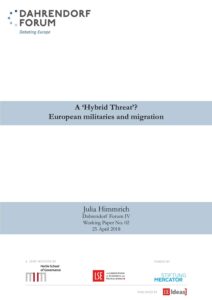Europeans have struggled to come up with a coherent policy towards immigration and irregular migration flows. This has been particularly evident in the response to the so-called ‘migrant crisis’, which has seen increasing flows of migrants from the regions south and south-east of Europe. Migration is now a policy area that has triggered both internal and external responses. Within the EU these two dimensions have become increasingly interconnected. In the external dimension, the military has become more visible, from EU and NATO operations in the Mediterranean to a new Italian mission in the Sahel, where the military has taken on a range of responsibilities including fighting human trafficking and smuggling, contributing to situational awareness, and deterring migration flows.
However, this military engagement has raised questions: What value does it add to civilian security operations? How effective is it? What consequences will military involvement have in the long term for the way Europe approaches migration?
This paper examines the driving forces behind Europe’s resort to the military to manage migration and proposes an alternative policy approach.
Julia Himmrich is a Dahrendorf Post-Doctoral Fellow at the London School of Economics.


